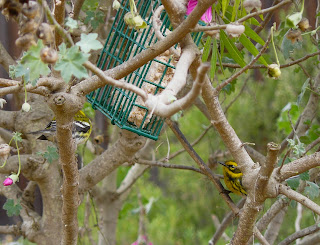The above photo was taken from the overlook; as I approached, a family that had been feeding the ducks crumbs, were leaving. The Mallard Ducks, being more skittish, moved closer to the water which left the Sparrows pecking at the crumbs. As I was watching the little darlings, a California Thrasher came into view - a most unusual sighting. Ca. Thrashers are usually off in the distance singing from atop a tall bush. I am hoping this Thrasher will appear on the "Easy Birding" walk in January. For a 24 second, could stand improvement Thrasher video, go to http://www.youtube.com/watch?v=6Hcp6sMyvFE&feature=em-share_video_user

On my last visit to the pond I saw a male Northern Pintail Duck - a first-time Cloisters sighting (photo from wikipedia - with tailfeathers). Male Pintails have long, pointy tail feathers, and this fellow was missing his tail. He was probably hanging around the pond waiting for his tail feathers to grow back. And sure enough his pointy tail feathers were sprouting, but they had a looong way to go. I am hoping this handsome male will make an appearance in January.
Since the majority of the Cloisters birds are located in and around the pond, it looks like "Easy Birding" will be easy birding.
















































